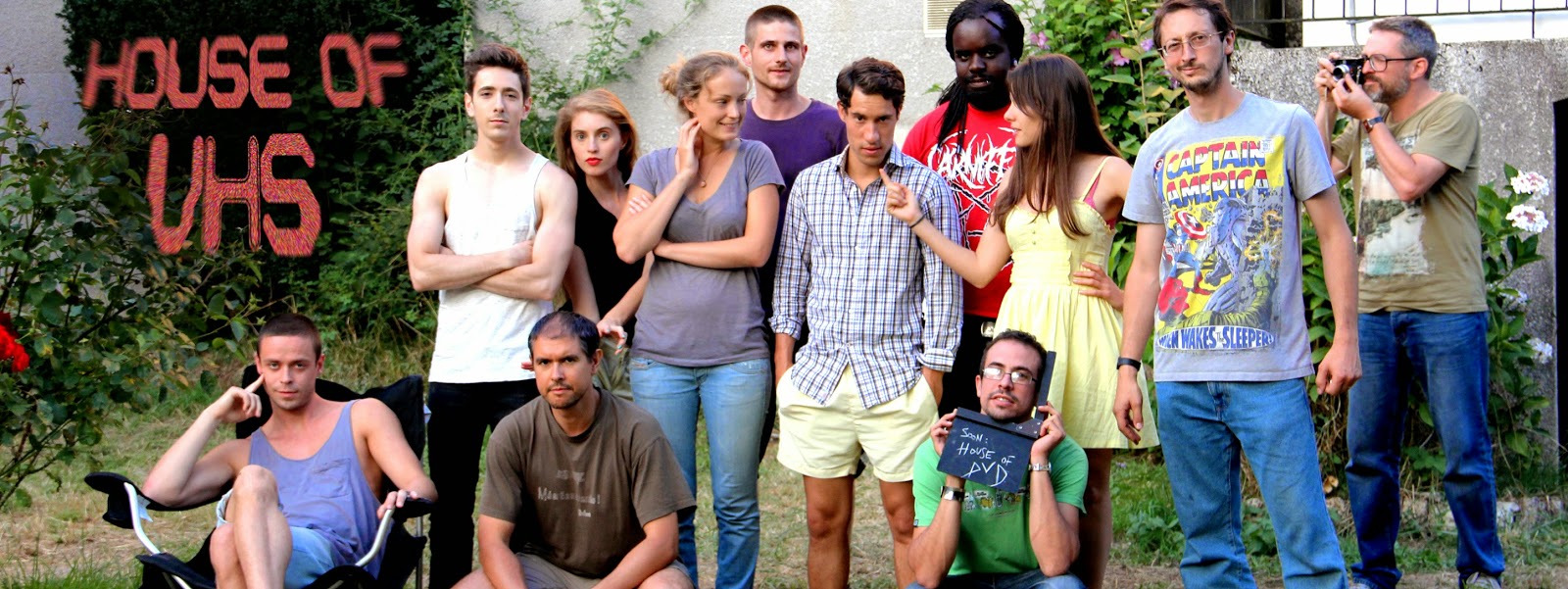Trying to produce and direct a film
like Sherlock Holmes vs Frankenstein, when you don't have the
money, the experience or the reputation, is a bit hot-headed. The
first step, I had been told by financiers, was to go microbudget for a first
feature directorial effort. I couldn't really make Sherlock Holmes on a
microbudget, so I concentrated on a script that would use as few
resources as possible. House of VHS: a haunted house movie, with six characters and
a supernatural element. Writing it was a blast, and we decided to
film in a house owned by Jean-Noël and his family, located in the
Center of France. We set filming dates in August 2013, and started
working on pre-production and financing simultaneously... in March. Fast-tracking the project was a good way to make it happen, but
also a gamble: what would happen if we couldn't pull it off? Five
months before filming, we had zero cast and crew, very little money,
and a script that was still a bit deliberately loose (it was designed
to be adapted to the actors in due time).
In April, we travelled to the house and
took a lot of pictures. I had never seen it before, and being there
allowed me to make a few changes in the script, in order to take advantage of
what the location had to offer. Then we started casting: in June, we
had our first casting call, where we met thirty actors and actresses (out
of 270 applications, which was way more than we had expected!). Four actors stood out: Isabel McCann, Delphine Lanniel,
Morgan Lamorté and Nafees Hamid. However, we still had a few people
to meet, and we needed to cast the last two characters. Two weeks
later, we had this second round of casting for House of VHS, with the four actors
above and a few new faces, among which Florie Vialens (now called
Florie Auclerc-Vialens) and Ruy (who calls himself Ewen Blumenstein).
We had found six talented actors who worked really well with each other, and
were all very excited to be a part of this project.
Then we gathered the crew. A small
one, to be honest: the budget and the house only allowed us to have
a full crew of six people, including Jean-Noël and me. We shoehorned in the planning
the presence of an SFX makeup artist for two days, but the rest of the
gang was only comprised of:
- director of photography
- his assistant
- sound recordist
- unit manager
To be fair, we would have needed twice
as many people and twice as much time, but complaining would have led
us nowhere. We were lucky enough to enlist François Reumont as
director of photography – an experienced TV professional, he had
shot a few short films like Zombinladen and Paris by Night of the
Living Dead, as well as feature film The Black Door.
Less than two weeks before filming began, Nafees had to drop out due to visa issues (he was a US student living in France), and we had to figure out how to replace him. You would think that the replacement would have been found among the actors we auditioned in June... but in fact, we chose an Icelandic actor called Pétur Sigurðsson, who was recommended by Ewen Blumenstein. He turned out to be great, showing up at the last minute and taking immediately the mantle of his character.
Less than two weeks before filming began, Nafees had to drop out due to visa issues (he was a US student living in France), and we had to figure out how to replace him. You would think that the replacement would have been found among the actors we auditioned in June... but in fact, we chose an Icelandic actor called Pétur Sigurðsson, who was recommended by Ewen Blumenstein. He turned out to be great, showing up at the last minute and taking immediately the mantle of his character.
So there we were, twelve people in a house
for two weeks, trying to follow a crazy schedule that involved
action, special effects... until we realized that the SFX makeup
artist had no intention of showing up. After having said that she had
prepared and tested everything, she simply stopped returning
phone calls. We suddenly had to handle the
fact that there was not going to be any on-set special effects in our
supernatural/horror film! A heavy rewrite was made on the spot, and I
left space for a few SFX shots to be added afterwards. When we got
back, we ran a small crowdfunding campaign, and managed to craft a
cool gory shot with the people who had made the monster eye for the
'Frankenstein' teaser. After having drawn a few FX scenes and concept sketches that never made it to the screen, Lucie finally storyboarded a new one that we were able to put in the can.
2014
Post-production on House of VHS has been forever, it seems. We are now in the second half of 2014, and it's not yet 100% completed. But we're almost there, thanks to all the people who joined and supported the project. It was not an easy one, but if we can survive this kind of hardcore filmmaking and turn over a satisfying movie, it should be no problem to handle Sherlock Holmes vs Frankenstein with a decent budget.
2014
Post-production on House of VHS has been forever, it seems. We are now in the second half of 2014, and it's not yet 100% completed. But we're almost there, thanks to all the people who joined and supported the project. It was not an easy one, but if we can survive this kind of hardcore filmmaking and turn over a satisfying movie, it should be no problem to handle Sherlock Holmes vs Frankenstein with a decent budget.






























